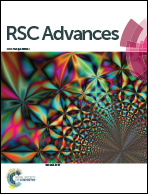Understanding effects of precursor solution aging in triple cation lead perovskite†
Abstract
The solution process is the most widely used method to prepare perovskite absorbers for high performance solar cells due to its ease for fabrication and low capital cost. However, an insufficient level of reproducibility of the solution process is often a concern. Complex precursor solution chemistry is likely one of the main reasons for the reproducibility issue. Here we report the effects of triple cation lead mixed-halide perovskite precursor solution aging on the quality of the resulting films and the device performance. Our study revealed that precursor solution aging has a great influence on the colloidal size distribution of the solution, which then affects the phase purity of the films and device performance. We determined the optimum aging hours that led to the best device efficiency along with the highest reproducibility. Dynamic light scattering revealed the formation of micron-sized colloidal intermediates in the solution when aged longer than the optimum hours and further analysis along with X-ray diffraction measurements suggested there were two chemical origins of the large aggregates, FA-based and Cs-based complexes.



 Please wait while we load your content...
Please wait while we load your content...